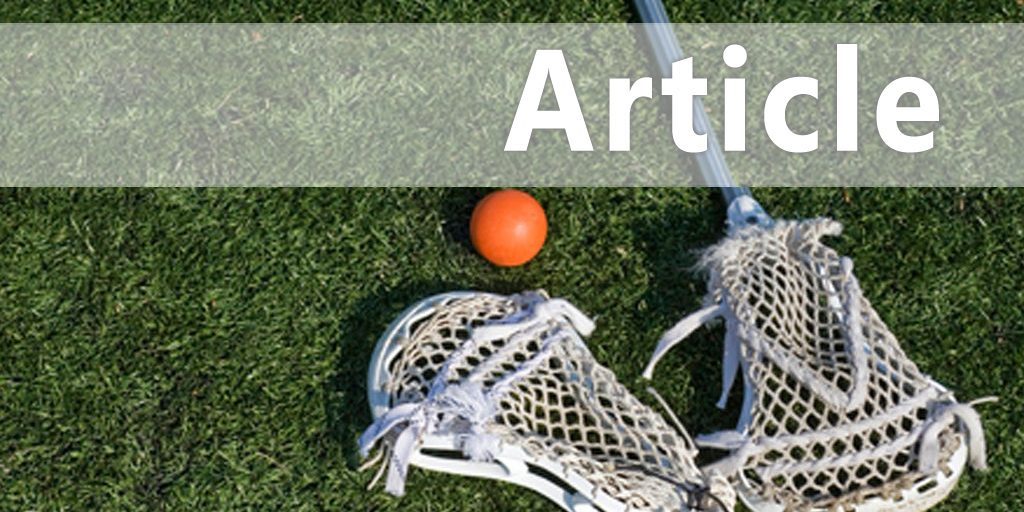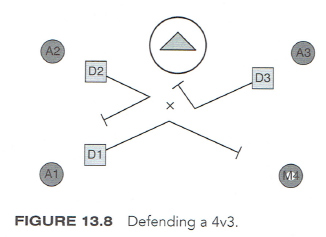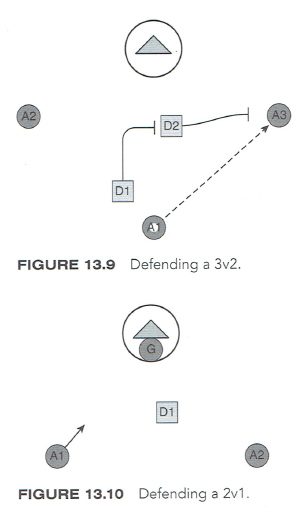|
Transition Defense - Types of Breaks By: Don Zimmerman and Peter England Originally Published in: Men's Lacrosse - Human Kinetics 
6v5 Break A 6v5 break (figure 13.6) may not be as apparent to the defense as other breaks because of all the player traffic. All defenders need to identify their matchups and communicate regarding which offensive player they are defending. If there is a 6v5 break, the defense has numbers to compensate for being one down on defense. However, if the defense is not aware of the break situation, a 2v1 opportunity can happen very quickly. The trailing defender should not yell "All even" until he is inside and checking out. At that point, the team is playing 6v6 team defense. 5v4 Break Against this break, the defense uses a box formation (figure 13.7). Typically, the close defense sets up in a triangle, and defender 4 comes down and sets up in the box. Defender 1 or defender 4 must first stop the ball carrier and make him pass. On the first pass, the defense will rotate into the flight of the ball. The defense must make sure they have the crease covered and have the ball carrier covered because he is the most dangerous player. The adjacent 4v3 Break When midfielder 4 passes to attackman 1, defender 2 slides inside to the hub and then out to attackman 1. Defender 2 wants to come out at a good angle and under control with his stick in port position to knock down passes and poke-check when within range. The last thing he wants is to be dodged by attackman 1. When midfielder 4 throws the ball, defender 3 slides to the inside hub and then out to attackman 2. When defenders slide, they must slide under control so they don't get dodged. Some teams like to drag defender 3 across the crease to help out with the passing lane from attackman 1 to attackman 3, but defender 3 should not screen the goalkeeper. 3v2 Break 2v1 Break When defending a 2v1 near the goal FIGURE 13.9 Defending a 3v2. (figure 13.10), the defender needs to drop down into the crease and compress his area of the defense. He wants to make his two opponents continue to come inside where their area to handle the ball is tight (instead of being out top where they have too much space). The defender is trying to buy some time so that help can arrive. The defender should use a V-up body position: He opens up so he can see both the ball (attackman 1) and the other man (attackman 2). He must not stare at the ball. He's playing "cat and mouse" between attackman 1 and attackman 2. On a 2v1, the defender is not playing the man with the ball (attackman 1). He is shading toward attackman 2 and is really playing attackman 2. Although the defender is off ball and can't make contact with the ball carrier (attackman 1), his stick is in a port position, ready to knock down a pass. As the defender closes, he is staying in that port position until he can get a piece of the ball carrier's glove. Eventually, the defender has to stop the ball. As attackman 1 gets closer, the defender will have to come in and get a piece of the attacker's gloves, whether attackman 1 throws or shoots the ball. The defender will eventually have to slide to the ball, but he doesn't want to do it too early. He doesn't want to make the decision for the man with the ball. The defender should make the ball carrier decide what his best option will be: pass or shoot. Transition defense is based on certain fundamentals, including ball possession, defending ball movement, communication, and trying to get more numbers near the goal to counteract the break situation. When your team commits a turnover, each unit has a function in trying to regain possession in a smart, efficient, and non-risky manner. Transition defense boils down to how a team and its individual players handle a 2v1 advantage for the other team. In the open field, defenders are more likely to give ground first before challenging the ball carrier. Near the goal, the defenders might not have that choice. Usually, the best policy is to compress the field so that defenders need to use minimal slides to chase the ball. This chapter examined various break situations and showed the importance of communication, patience, and working as a coordinated unit.
|





 defenders should be in skip lanes. The defense is leaving the farthest man from the ball open, but defenders are trying to split two attackers if they can. On each pass, the defense continues to rotate into the ball. Low defenders stay in front of the GLE because the defense doesn't go behind the goal. If an opposing attackman drives to the cage from behind the goal, a help- side defender may slide across the crease (coma slide) to play this attackman. If an off-ball player cuts inside, a defender should cover him and release him to a crease defender so that the first defender can get back into the rotation. If a defender is trailing the ball, he will go away from the flow of the ball.
defenders should be in skip lanes. The defense is leaving the farthest man from the ball open, but defenders are trying to split two attackers if they can. On each pass, the defense continues to rotate into the ball. Low defenders stay in front of the GLE because the defense doesn't go behind the goal. If an opposing attackman drives to the cage from behind the goal, a help- side defender may slide across the crease (coma slide) to play this attackman. If an off-ball player cuts inside, a defender should cover him and release him to a crease defender so that the first defender can get back into the rotation. If a defender is trailing the ball, he will go away from the flow of the ball.




